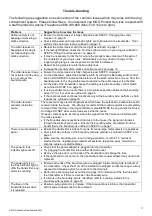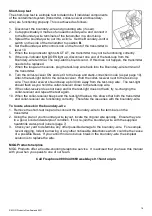
3
© MGG Products New Zealand 2021
Contents
A standard system will contain the following:
•
1 x transmitter
•
1 x 12v mains adaptor
•
1 x collar-receiver unit
•
1 x collar strap
•
1 set each of long & short prongs (contact-points)
•
1 x collar-receiver test light
•
1 x 5v USB mains adaptor
•
200m boundary-wire
•
6 x waterproof heat-shrink joiners
•
1 x set of boundary training flags
•
Instruction manual
You may have ordered additional wire or collar-receivers, please check these against your invoice
Additional items you may need
•
Tape measure
•
Drill & mounting hardware
•
Flat-edged spade or lawn edger
•
Pliers
•
Wire stripping pliers
•
Scissors
•
Lighter
•
Electrical tape
•
Additional MGG waterproof heat-shrink joiners
•
Cable ties
•
Ground rod & clamp
•
Waterproofing compound (e.g. silicone caulk)
•
Length of hosepipe if crossing a driveway
Key-words
Transmitter
- the device that transmits the radio-signal through the boundary wire
Dog containment area
- the area within the containment boundary where your dog can roam
freely
Static-correction zone
-
the area where your dog’s collar-receiver will emit a beep & static
correction as signals to return the dog to the dog containment area
Boundary-width
- the distance between the start of the static-correction zone and the boundary
Collar-receiver
- the device that receives the radio-signal from the boundary wire
Prongs (contact-points)
- the metal prongs which screw onto the collar-receiver. These are the
contact-points through which the collar-receiver delivers the safe static-correction when your dog
moves into the static-correction zone
Power-input socket
- this connects the 12v mains adaptor into the transmitter
Boundary-control switch
– located on the side of the transmitter, this switch has three options to
select the length of boundary-wire being used
Ground terminal
- the terminal where the ground wire connects to the transmitter
Boundary-wire terminals
- the terminals where the boundary-wires connect to the transmitter in
order to complete a continuous loop
Loop indicator light
– this light indicates that the boundary-wire makes a complete loop which
enables the signal to be transmitted. This will illuminate to indicate the system is working
Boundary-width control
- an adjustable knob on the front of the transmitter which adjusts the
width of the static correction zone. It does not adjust the level of static-correction delivered by the
collar-receiver




































